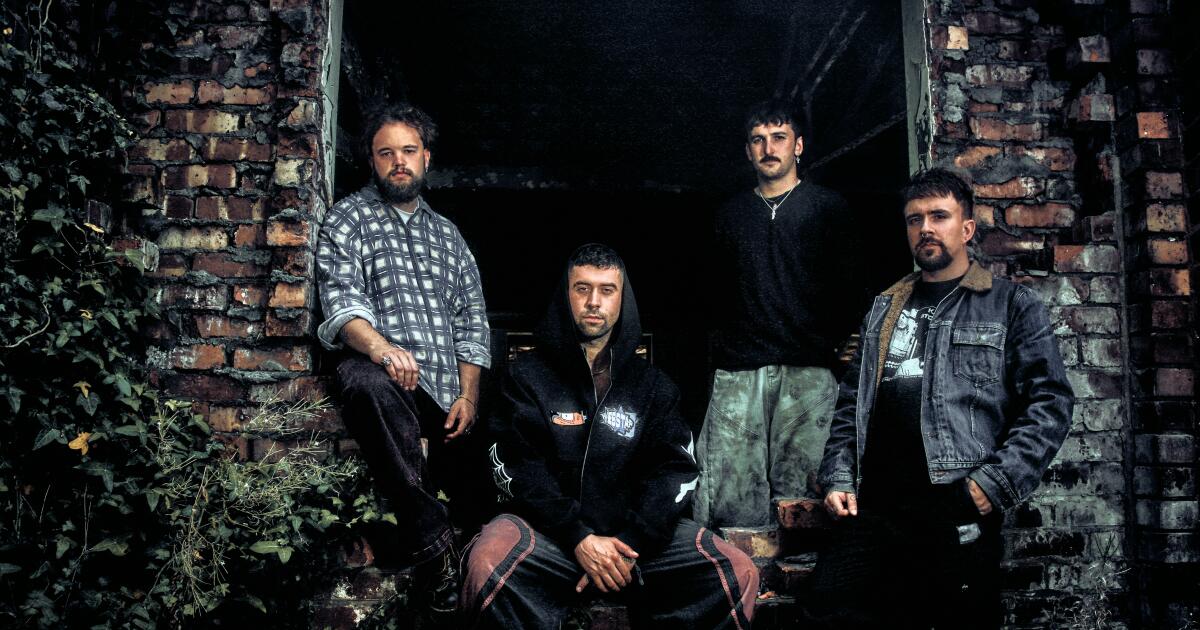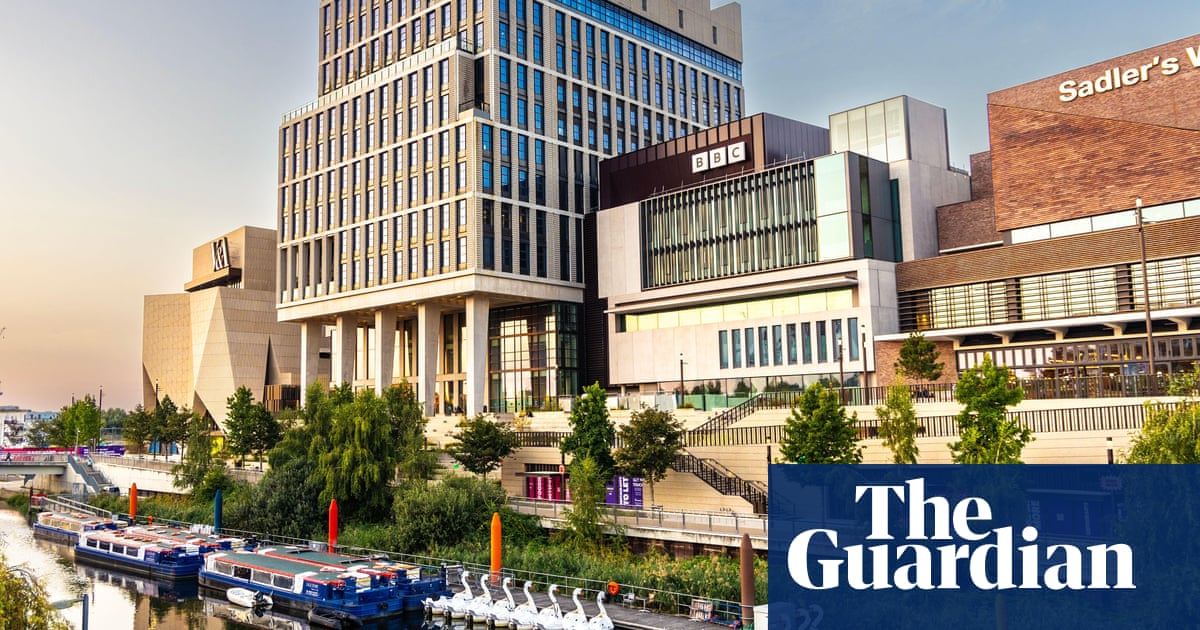Maruja talk about their exhilarating debut album, ‘Pain to Power’
Maruja’s music isn’t merely following the times; it’s a reflection of them.
The rock band, whose debut album “Pain to Power” was released Friday, has carved out a niche in today’s music scene, garnering praise and raising eyebrows for their innovative instrumentation and song composition.
But the Manchester-born quartet — Harry Wilkinson, Matt Buonaccorsi, Joe Carroll and Jacob Hayes — has already done the forming, recording, and touring trifecta.
This can largely be credited to their three EPs, “Knocknarea,” “Connla’s Well” and Tir na nÓg,” released in 2023, 2024 and 2025, respectively. Each project draws on elements of post-punk, jazz rock and art rock that blend in an enthusiastic musical cocktail.
“We began touring, and then it kind of hasn’t stopped since,” Carroll says with a laugh, via a Zoom call. “That was about two and a half years ago… towards the end of last year, we did about four months, 47 shows all around Europe.”
And they haven’t let up. As soon as they got home from touring, they were right back to it. Altogether, the “best ideas” of “Pain to Power” were written and recorded over the span of two months: January and February of this year, when the band made the studio its second home.
“We had to just go ‘ham’ in the studio for six days a week. It’s pretty hardcore,” he says.
Some tracks had “spawned from jams” before being shelved for a while: “Some of them took two hours, some of them took two years,” he puts it plainly.
But this wasn’t an issue for the band, as they picked up those “jams” like they’d never put them down.
“All the songs we’ve written, they feel like they’re still within the same world, but just through different filters sometimes,” Buonaccorsi says.
“Born to Die,” which existed for the better part of the last couple of years, represents the halfway point in the album and features one of its most impressive sonic shifts. It also takes on the herculean task of merging many of the ongoing tones and deepest themes of the project.
“I know what this life is worth / We are universal spirits / And our kingdom is this Earth,” Wilkinson opens, as if a light has shone down on him.
The song is soft, with a distant, wailing sax peeking in for a brief moment among drum lines. It’s almost symphonic, carrying on for almost seven minutes before descending into a lulling silence.
“Our feelings are just visitors / Competing for attention / Avoiding every trigger / While still reaching for ascension,” he continues, in a quasi-monologue.
Hayes breaks in, thrashing his drums alongside Wilkinson’s guitar and an enthralling bass line from Buanoccorsi. Naturally, Carroll’s sax follows suit. The song then recedes into serenity once again, before picking up on “Break The Tension.”
It’s an exhilarating ride that carries on over the rest of the album, ebbing and flowing between chaos and calm. A lot of “Pain to Power’s” strength is in its latter half, and particularly across the three track run that is “Trenches,” “Zaytoun” and “Reconcile,” the album’s nearly 10-minute closer.
“What you’re seeing is these notions of pain that we are getting out of us in these songs,” Wilkinson explains. “These aggressive songs like ‘Bloodsport,’ ‘Look Down On Us’… we’re turning all of that aggression and that pain and anger into something beautiful, and that’s reflected in a track like ‘Saoirse.’”
“It’s quite a dynamic album,” Buonaccorsi adds. “You’ve got quieter songs, more intimate songs, and you’ve got loud, bombastic, crazy, aggressive songs, but they all still feel like they’re part of the same sonic universe.”
“Saoirse,” the third track on the album, reflects the somber first half of “Born to Die.”
“It’s our differences that make us beautiful,” Wilkinson sings repeatedly, like he’s muttering out a mantra. Sure, it’s a bit on-the-nose, but it embodies what Maruja is all about.
“Saoirse,” which translates to “freedom” or “liberty” in Irish, has historically morphed into a term representing the country’s desire for independence from British rule and cultural autonomy. These allusions to Ireland are ever-present in the band’s creations, with titles such as “Tir na nÓg” and “Connla’s Well” specked across their discography.
But how did a British outfit become synonymous with Irish activism?
“When we were recording ‘Knockarea,’ my dad started getting really ill and that led to me connecting with his parents a lot more, and they told me about my great-granddad, who was a photographer,” Carroll remembers.
“We ended up using all of his photos for the early stages of the music… all the black and white stuff is my great granddad’s photos in Ireland… I got really into my Irish heritage, and I’m really proud of it… and feel very connected to the culture and the land,” he continues.
The group says it has a strong correlation with their avid support for Palestinian rights, which the Irish have shown for decades: “They were the first Western government to speak up in public support for the Palestinian people,” Hayes says.
In that, they’re also speaking out against their home, Britain, which they say is “entirely complicit” in the Israel-Palestine conflict.
“The colonization of Ireland from the British Empire, and then the… secret police of the Black and Tans [in Palestine] is a direct relation to the colonialist and imperialist ways of the British government today,” Hayes says.
According to the Irish Times, Winston Churchill demanded a “picked force of white gendarmerie” be deployed in Palestine after facing unrest in 1921. The force was composed of “members of both” his Auxiliaries and Black and Tans, who were “assigned to Palestine once their presence in Ireland was no longer deemed necessary.”
“In England, we just see this deranged hypocrisy continue to lord over our political landscape,” he adds. “We want to give voice to those who are voiceless… If we can help raise awareness, raise a message, and… highlight the complicity of our government, we’ve got to do it.”
On “Bloodsport,” this is clear, with Wilkinson crying out pleas to the world.
“Complicit in the narrative of pacified killings it’s a / Sore sight when you gotta choose / The lesser of two evils either one will prove / That we’re socially in apathy what’s left to lose?”
Their activism is heavily tied to their music and has undoubtedly contributed to some of the band’s recognition on a global scale. But, to them, it’s just part of their responsibility, and their music is an indication of that.
“We’re just reflecting our environment,” he explains. “Our lives are downtrodden with politics and with war and with the world suffering.”
Buonaccorsi chimes in, referencing a quote from “the great” Nina Simone: “An artist’s duty, as far as I’m concerned, is to reflect the times.”
“It’s our job… to speak about things that really matter to us, things that we feel like should not be happening in this world,” he says. “The barbarity and horror that we’ve never been able to see in our lifetimes… now, we see it before our eyes on phone screens.”

